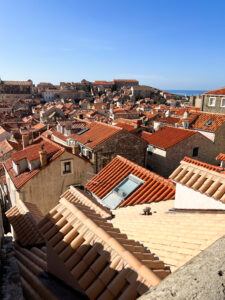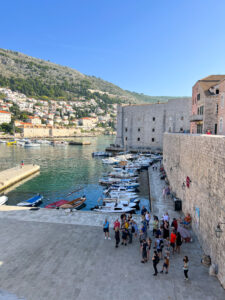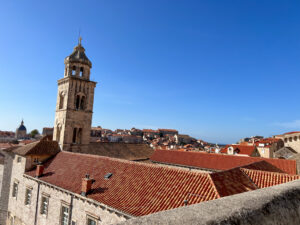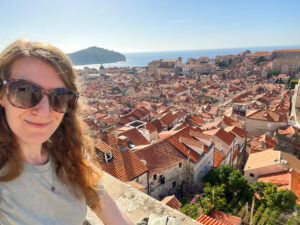

As I left my hostel in Zagreb, I felt like a newborn creature who hadn’t figured out legs yet. It had been a week since I found out I had covid, and I was finally feeling better, but I was still very weak, and carrying my bags was a challenge. The colors outside as the Uber drove me to the bus station seemed too bright. By the time I got through the station and onto the bus, I was so drained that I felt like I was having an out-of-body experience. It was a 5-hour bus ride down to Split. The one bright side of feeling so insane was that I wasn’t nervous on the ride. We rode through the mountains on roads that would typically send me into panic spirals, and I watched, dazed, through the bus window, marveling at the fall colors in the trees. I’d assumed that I wouldn’t see many fall colors after leaving Romania, but I was wrong—fall was waiting for me there in the mountains of Croatia.
I was lucky, I thought, as I gazed out the window. I’d lost money from having to cancel two Airbnbs (one in Split and one in Korcula) and two bus tickets to Plitvice Lakes and back. Plus I’d had to book a new last-minute Airbnb in Split the day before, but overall, my sickness hadn’t derailed my budget or itinerary nearly as much as I’d feared it would.

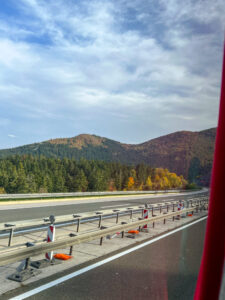
When we arrived in Split, I realized that I wouldn’t be able to take an Uber to my Airbnb due to the perplexing fact that my Airbnb was inside the pedestrian-only palace walls. I couldn’t envision what this meant or what to expect from my $60 room. It turns out that about half of the Old Town of Split is inside the walls of what used to be the Roman Emperor Diocletian’s palace in the 4th century AD. The walls on 3 sides of the palace are still standing, and you enter in through grand, stone gates that truly do make you feel as though you are entering a city in Game of Thrones (many scenes of which were filmed there). I only had an evening and one night in Split before heading south to Dubrovnik the next morning (I returned to the city for a longer visit the next week), so I had no agenda except to wander around in my wide-eyed stupor.
I walked at an unimaginably slow pace from the bus station toward the fortress-like-palace, stopping to rest every 30 feet. I had Airbnb directions that served me nearly no purpose because I couldn’t even figure out where I was to know where to start. I didn’t care. I was happy to creep around like an overheated turtle until I passed out. It was one of the most beautiful Old Towns I’d ever seen. Somehow after wandering down several miniscule alleys and turning 4 million times at random, I found the apartment in the photo—a small apartment at the top of an outdoor stairway overlooking a restaurant. I’d booked it the day before because I’d lost my original reservation when I had to extend my stay in Zagreb, so my expectations were low. But the place was gorgeous and exactly what I needed to help me feel more like a functioning human. My appetite had even started to return, so I ventured back out into the labyrinth after dropping off my bags and found a beautiful restaurant that I would typically bypass because of the menu prices. That night, I couldn’t be bothered to look for a better bargain, and I ate handmade pasta at a candlelit outdoor table down a tiny alley as a magician showed me magic tricks, then I waddled back to my queen-sized bed and slept like a brick.



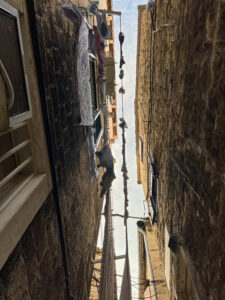

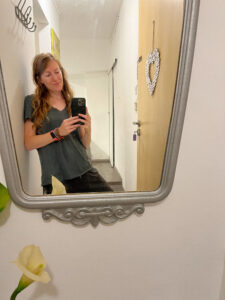
The next morning, I woke up feeling worse again. It was disheartening because I’d assumed I would steadily improve, but again my head felt like it was too large for my body and also full of lead weights. I trudged even more slowly to the bus than I had the day before, wondering if I’d made a mistake in ever leaving my hostel in Zagreb. It was 4 hours to Split, and the mountains outside the bus windows got bigger and bigger as I dozed in and out of sleep. We were delayed, and it was evening when we arrived, and it didn’t take me long at all to realize that Dubrovnik would not be my favorite city in Croatia.
An Uber dropped me off at the gates to the Old Town. Similar to the palace walls in Split, Dubrovnik’s Old Town is surrounded by ancient city walls, parts of them from as early as the 11th century. When people picture Croatia, they likely picture Dubrovnik. In the past several years, Dubrovnik’s popularity has exploded. Largely this is because of the film industry—specifically it’s because of Game of Thrones. Games of Thrones creators picked Dubrovnik to be the setting for Kings Landing, and suddenly the city became a destination on the radar of every person who considered themselves a fan of the show, which is to say… practically everyone. (Also Stars Wars: The Last Jedi was filmed here, plus a dozen other popular shows and films.) Fifteen years ago, Dubrovnik was something of an up-and-coming gem in the Balkans, but today it’s a tourist hub where you can’t walk ten feet without seeing an overpriced Game of Thrones trinket. In the summer, photos of the crowds look like New Orleans on Mardi Gras day. I had hoped that late October would mean a quieter visit. And it was fairly quiet, but I couldn’t escape the feeling that I’d just arrived in Disney World.



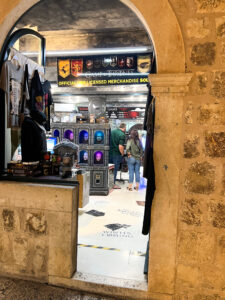
To be clear, Dubrovnik is stunning. It is worth visiting to see a place so beautiful. The historic center of Dubrovnik is considered one of the best-preserved medieval city centers. And yet… I missed Croatia. The city was devoid of the rest of the country’s culture. As gorgeous as it was, the beauty felt manufactured instead of authentic, and it reminded me of how I heard once that Disney World touches up the paint in Magic Kingdom every night. The prices were outrageous compared to the prices I saw in the rest of the country—I hadn’t seen prices so high since I left Italy in the height of tourist season, and even those prices were probably more reasonable. The restaurant prices were double what I’d seen in months, and the food was generic and bland.
Some travelers claim that Game of Thrones ruined Dubrovnik. I don’t think that’s fair. The city chose how to respond to the influx of tourism, and they didn’t have to choose this response. But being in the city made me think about the ethics of tourism and my role and responsibility as a tourist, the same way I grappled with the issue when I visited the nearby (but far less visited) Kotor (which I wrote about here). And I DO think that Dubrovnik is worth seeing. If you are a Game of Thrones fan or a film enthusiast, there are many tours in the city that are probably fascinating. As a moderate fan, I was not the target audience for this, but it was still neat for me to see many of the filming locations. I would encourage everyone to not make this the main destination of their vacation but rather a stop for a night or two. The culture of this region is fascinating, and it would be a wasted opportunity to be so close but entirely miss it.
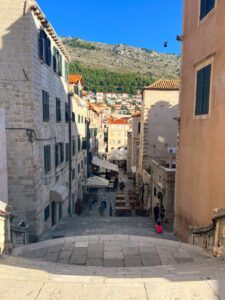
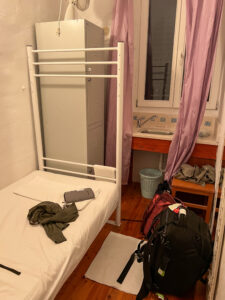


I spent a night in a (surprisingly affordable) tiny private room in an Old Town hostel, and the city’s church bells woke me up. I spent the next morning walking the top of the city walls—an activity you absolutely can’t miss if you visit Dubrovnik. It cost $33 to do the walk—an amount that I spent in an entire day (including accommodations) in nearby cities—and I asked the ticket seller if the prices were always this high. “No,” he said, as if that were a silly question. “Just in the past few years since you people from the West started coming,” and he winked at me. The sun beamed down on me as I wobbled on weak legs around the top of the city walls with views that would leave anyone in awe. I visited Lovrijenac Fortress (the Red Keep in Game of Thrones) for the views. And then I was so exhausted that I sat inside a quiet church reading for an hour.
I had originally planned to spend 2 nights in Dubrovnik, but I canceled a night at the last minute. I checked out of my room and caught a taxi back to the bus station to head back to a place I hadn’t been able to stop thinking about since my first visit—Bosnia.

